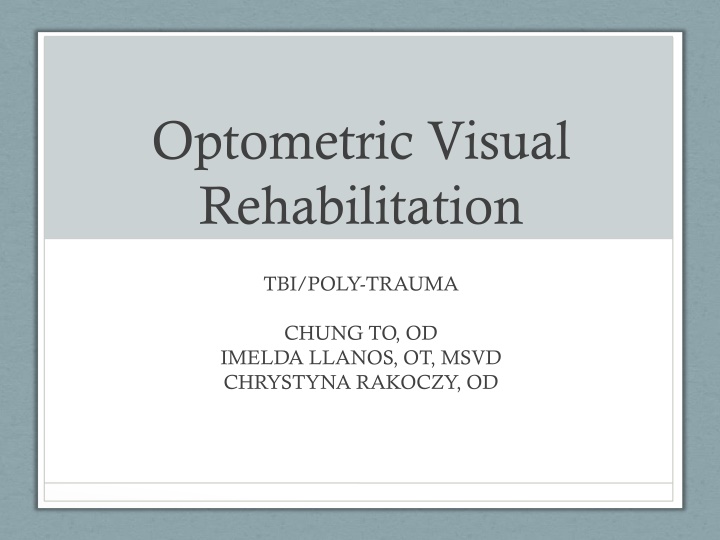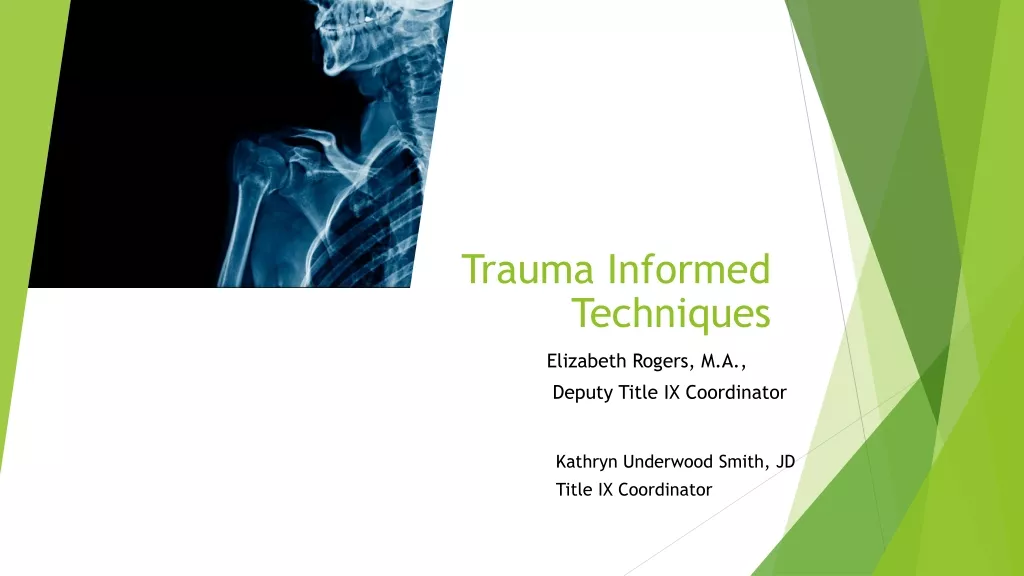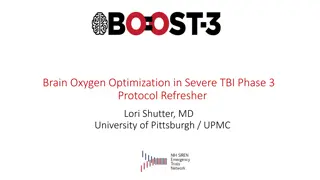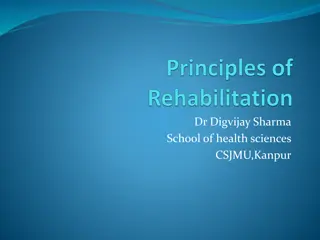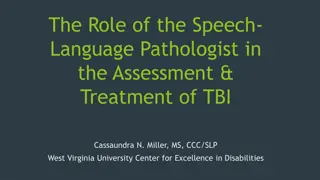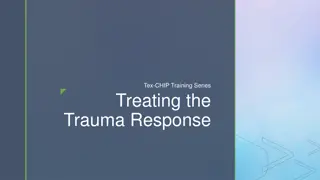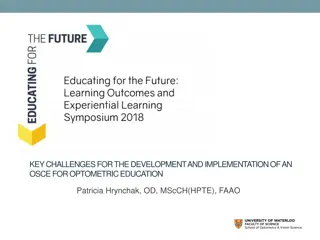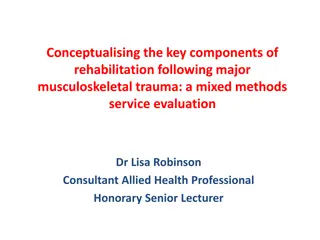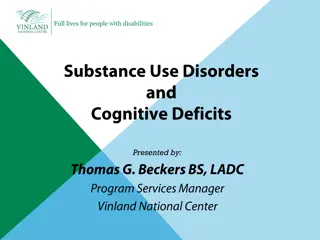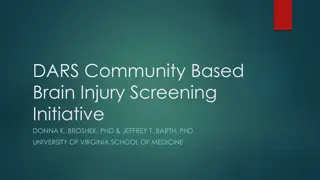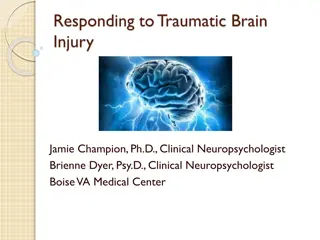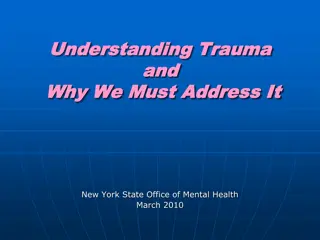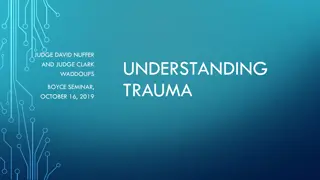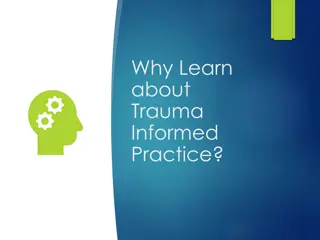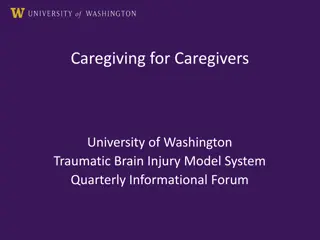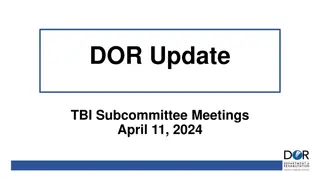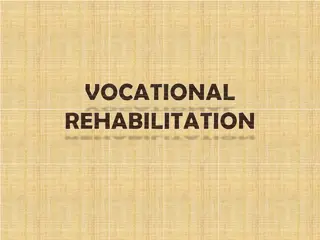Optometric Visual Rehabilitation for TBI/Poly-Trauma Patients: Principles and Considerations
Optometric Visual Rehabilitation involves the comprehensive treatment of visual system disorders, including binocular vision, accommodation issues, and more. Neural plasticity plays a key role in neuro-rehabilitation, allowing the brain to adapt and learn. The 10 principles of neural plasticity guide effective rehabilitation, emphasizing factors like intensity, repetition, and time. Considerations for TBI/Poly-Trauma patients focus on cognitive, perceptual, and visual challenges, with proactive management strategies to address the varied prognosis and treatment needs.
Download Presentation

Please find below an Image/Link to download the presentation.
The content on the website is provided AS IS for your information and personal use only. It may not be sold, licensed, or shared on other websites without obtaining consent from the author.If you encounter any issues during the download, it is possible that the publisher has removed the file from their server.
You are allowed to download the files provided on this website for personal or commercial use, subject to the condition that they are used lawfully. All files are the property of their respective owners.
The content on the website is provided AS IS for your information and personal use only. It may not be sold, licensed, or shared on other websites without obtaining consent from the author.
E N D
Presentation Transcript
Optometric Visual Rehabilitation TBI/POLY-TRAUMA CHUNG TO, OD IMELDA LLANOS, OT, MSVD CHRYSTYNA RAKOCZY, OD
Definition Optometric Visual Rehabilitaion: rehabilitation of the entire visual system to include: The eye and surrounding structures Binocular vision, accommodation, and eye movement disorders Higher order visual functions: Spatial organization Object perception Visual memory Visual thinking Allocation of visual attention Integration of visual information with other sensory and output modalities
Neural- Plasticity Basis for all neuro-rehabilitation (including Optometric Visual Rehabilitation) Overwhelming evidence supportive of neural plasticity (structural and functional changes in brain circuitry) Mechanism by which the brain encodes experience and learns new behaviors Allows the intact brain to learn and the damaged brain to relearn (given the right guidance and experiences)
10 Principles of Neural Plasticity 1. Use it or lose it 2. Use it and improve it 3. Specificity 4. Repetition Matters 5. Intensity Matters
10 Principles of Neural Plasticity 6. Time Matters 7. Salience Matters 8. Age Matters 9. Transference 10.Interference
Considerations for TBI/Poly- Trauma Patients Associated neurologic, cognitive, and physiologic disorders (attention, language, memory, and emotional problems are common) Four primary factors affecting treatment: Cognitive and perceptual problems Visual field loss Ex- cyclotortion Sensory fusion disruption syndrome
Considerations for TBI/Poly- Trauma Patients Stumbling blocks (active and/or passive considerations) Prognosis results are typically more variable and less predictable Type and severity of trauma does not correlate to vision problems When to step back Endpoints during therapy Logistics: realistic scheduling, expected duration
Sequential Considerations Optical correction of ametropia Added lens power Prisms (vertical, horizontal) Occlusion for diplopia Optometric Visual Rehabilitation Surgical
Occupational Therapist (OT) and Optometric Visual Rehabilitation Role in Optometric Visual rehabilitation: improve the ability of individuals to accomplish the everyday tasks they need and/or want to do 3 principle components Person (physical/sensorimotor, cognitive, and psychological/emotional abilities) Environment (physical, social, socio/cultural) Task (activities of daily living, work, play)
OT Assessment Review symptoms and reasons for visit Vision impairment history Life style checklist Convergence Insufficiency Symptom Survey (CISS) Explain nature of vision problems Explain proposed treatment and prognosis for improvement Discuss time commitment Open questions and discussions
OT Assessment Functional Assessment: Developments Eye Movement (DEM) Visagraph testing (visual skills, numbers, reading) Useful Field of View (UFOV) screening Perceptual Assessment: Visual attention subtest of the Brain Injury Visual Assessment Battery for Adults
Developmental Eye Movement (DEM) Visual-verbal timed and standardized test of saccadic eye movement in reading in children Assess oculomotor function on the basis of speed with which a series of numbers can be seen, recognized, and verbalized with accuracy No norms available for adult English speakers for the original single-digit version of the DEM Results for adults are extrapolated
Developmental Eye Movement (DEM)
Visagraph III Computerized reading analysis for objective eye movement recording Uses infrared monitoring glasses Provides information about: Number of fixations Regressions Duration of fixations Reading rate Relative efficiency Grade Equivalence
Useful Field of View (UFOV) Computer- administered and computer scored program Test of functional vision and visual attention Meta-analysis data supports UFOV as a valid and reliable index of driving performance and safety Test consists of 3 subtest that assess speed of visual processing under increasingly complex task demands Scores based on accuracy not reaction time Obtains 75% correct threshold for correct performance Normative data available
UFOV Subtest 1: Processing Speed Examinee identifies a target (car or truck) presented in a centrally located fixation box that is presented for varying lengths of time Score reported in milliseconds Normal central vision and processing speed: >0 but <30
UFOV Subtest 2: Divided Attention Examinee identifies a centrally presented object and locates a simultaneously presented car displayed in the periphery Score reported in milliseconds Normal divided attention ability: >0 but <100
UFOV Subtest 3: Selective Attention Same as subtest 2, except that the car displayed in the periphery is embedded in a field of 47 triangles or distractors Score reported in milliseconds Normal selective attention ability: >0 but <350
Brain Injury Visual Assessment Battery for Adults Visual Attention Assessment Single letter search: Simple and Crowded Word search Structured complex circles search Random plain circles: Simple and Crowded Random Complex Circles Search Telephone Number Copy Design Copy: House, Flower, Clock Scanboard
OT Treatment Approaches Remedial approaches Eye exercises for muscle imbalance Stabilization of fixation, saccadic eye movements, and smooth pursuits Increase accommodative abilities Sustain vergence (convergence/divergence) demands Activities to obtain fusion Cognitive and perceptual approaches Compensatory approaches Scanning for visual field deficits Cognitive and perceptual approaches
Neuro-Optometric Rehabilitation The overall process: Phase I: Visual input stability/sustenance Phase II: Binocular integration/facility Phase III: Output stability Note: the compartmentalization of phases is a progressive terminology presented based on ongoing reviews of publications and personal experience There is significant overlap between each phase with each building a foundation for the next Can be used as an overview to Optometric Visual Rehabilitation/Neuro-Optometric Rehabilitation
Phase I: Input Stability/Sustenance Enhance the stability of the visual input system: Clarity of vision Monocular accommodative abilities Quality of ocular motor system: fixation, range of ocular motility, smooth pursuit, saccades Sustenance Binocular stability (focus on gross convergence/positive fusion vergence)
Phase II: Binocular Integration/Facility Enhance binocular control alignment and sustenance with integration of intermodal sensory processing Accommodative fusional vergence (postive/negative) Enhance sensory motor fusion/speed of recovery of fusion Accommodative facility Expand peripheral awareness VOR: integration of ocular saccades and pursuits with balance and visual -motor performance Proprioception integration
Phase III: Output Stability Developing speed of visual information processing (stability of output) Top-down processing (facilitated by dorsal and ventral processing streams in vision) Dorsal: control of visually guided movements Ventral: facilitates recognition of objects, form and detail Top-down processing: translates into speed of information processing (decoding) and performance (decoding) Jump fusional vergence Binocular accommodative facility
Feedback Mechanisms Diplopia Blur Suppression Luster Kinesthetic awareness SILO (small in, large out) Float Localization
Multidisciplinary Care Integration of rehabilitation and compensatory strategies with other disciplines Physical therapy Speech and language specialist Orientation and Mobility specialist Low Optometric Visual Rehabilitation
Re-assessment by OD Binocular vision assessment (direct and indirect measures) Vergence balance (vertical and horizontal) Convergence amplitude (near point of convergence) Sensory status (W4dot, stereopsis) Accommodative assessment (direct and indirect)
Summary Neural plasticity is basis for Optometric Visual Rehabilitation/ Neuro-Optometric Rehabilitation Special Considerations for the TBI/Poly-Trauma patient Multidisciplinary care
References Scheiman, Mitchell, and Bruce Wick. Clinical Management of Binocular Vision: Heterophoric, Accommodative, and Eye Movement Disorders. Philadelphia, PA: Lippincott Williams & Wilkins, 2013. Print. Kleim, J. A., and T. A. Jones. "Principles of Experience-Dependent Neural Plasticity: Implications for Rehabilitation After Brain Damage." Journal of Speech, Language, and Hearing Research 51.1 (2008): S225-239. Print. Windsor, Richard L., Craig A. Ford, and Laura K. Windsor. "UFOV: Useful Field of Vision." Bioptic Driving USA. The Low Vision Centers of Indiana, n.d. Web. 11 Jan. 2014. Useful Field of View. 2004. MS. Birmingham. Web. 11 Jan. 2014. Edwards, J., L. Ross, V. Wadley, O. Clay, M. Crowe, D. Roenker, and K. Ball. "The Useful Field of View Test: Normative Data for Older Adults." Archives of Clinical Neuropsychology 21.4 (2006): 275-86. Print. Suter, Penelope S., and Lisa H. Harvey. Optometric Visual Rehabilitation: Multidisciplinary Care of the Patient following Brain Injury. Boca Raton: CRC, Taylor & Francis Group, 2011. Print.
